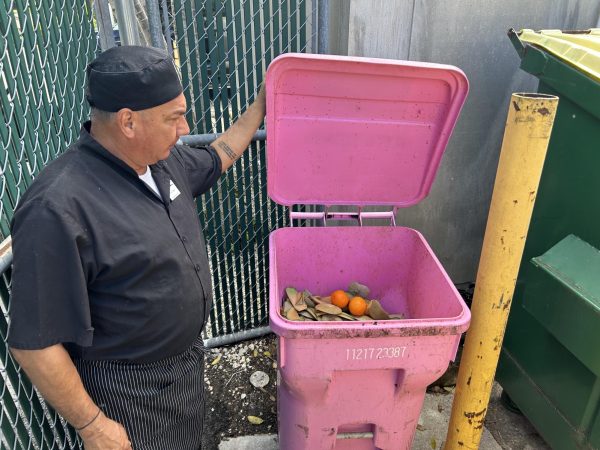Security updates address post-Parkland challenges
From badges, to class bells that talk, to reinforced classroom door locks, Ransom Everglades has taken extra steps to improve its campus security in the wake of the escalating dialogue about school safety.
“I imagine every school is wrestling with the security bear,” said Mr. Raymond Stewart, RE’s Chief Technology Officer. “How can people get onto campus, what do we do if somebody makes it on campus, and are we geared to be able to support our community in a thoughtful way?”
The intention of security updates is twofold. The events of Marjory Stoneman Douglas have forced schools across the nation to reevaluate campus safety, and RE has been sensitive to this concern. There is also the challenge of expansion — the acquisition of La Brisa, new construction projects, and an increased student population have all necessitated a greater focus on security and emergency preparedness.
Vigilance is especially important with the presence of construction teams on campus, according to Ms. Tammy Anthon, Securitas site supervisor.
“With construction being here, it’s a lot more strict as to who’s on campus, who’s allowed on campus, and who’s supposed to be walking around campus,” Ms. Anthon said. The new Raptor system will also help with this issue. It scans the IDs of on-campus guests and checks their names against national registries to make sure they will not threaten campus safety.
Mr. Stewart explained that until January of last year, Raptor was only used for visitors. In early 2018, the Raptor system was updated, and it now keeps track of the comings and goings of RE students. In the case of an emergency, teachers will have accurate rosters of who is on campus.
Used in tandem with the Raptor system is another new security measure: ID badges. The badges, which can be scanned by Raptor, facilitate students’ signing in and out. Beyond that, however, students seem to find little use for the badges.
“People tell me all the time that they don’t like [the badges], that they lost them, that they copied the number down and realized they could [type it into the Raptor machine],” said Mr. Stewart. “I know it feels burdensome — ‘You know me, why am I carrying my picture around my neck?’”
However, as Ms. Lindsay Danielson, Upper School Dean of Students, pointed out, badges also serve another purpose. The badge system “is a very easy visual way to identify who should be on our campus and who, perhaps, we need to inquire about,” she said. Both RE campuses welcome visitors of all sorts; especially for new students, Mr. Stewart noted, badges are a helpful indicator of who is “one of us.”
Mr. Stewart said that ultimately, the goal is for RE’s badge system to emulate that at many colleges, giving students as much independence as possible. Soon, students will use badges to activate printers and check out library books, and Mr. Stewart hopes to one day provide badge access in the bookstore and at vending machines. He is looking to students for more suggestions: “I want [the badges] to feel like change that students are apart of, and not change that’s being done to you.”
Beyond digital technology, new measures have been taken to secure RE classrooms. A small box of Nightlock Lockdown bolts, which can be used to anchor the door shut during school lockdowns, is included in every classroom. The new intercom system also contributes to classroom safety.
“That is a two-way microphone,” explained Ms. Danielson, “so Ms. Regis, Ms. Lacayo, or I could call into a room and try to figure out where a student is, or in the event of an absolute emergency, be able to communicate into particular rooms to give specific directions.” Telephones in every classroom also ensure that students will be well-prepared to seek help if necessary.
And, the campus continues be secured by a network of security cameras and a visible police presence at the front gate. A conspicuous police car parked at the entrance to our school, said Ms. Danielson, can act as a deterrent to crime.
In case these measures fail to prevent a crisis, Ransom Everglades faculty have been taught how to react during lockdown emergencies. They attended a training session led by Securitas, the school’s new security company, which operates in countries around the world.
In the training session, Ms. Danielson said, a Securitas representative endorsed the “Run-Hide-Fight” response. When faced with an active threat, it is best to flee to safety. However, if this is unsafe or impossible, students are advised to hide in classrooms and away from windows, which the current lockdown drill simulates. Fighting is a last resort.
“It was a hard thing to listen to, because unfortunately it’s become part of the reality of working in schools, but I do think it’s something that we need to be aware of,” Ms. Danielson said.
To better support school-wide communication during emergencies, Ms. Danielson has proposed an idea for a mobile app. “The reality of emergencies is that you get caught off guard, often,” she explained. Teachers do not always have time to find physical copies of class rosters and other important information.
Ms. Danielson’s app would provide teachers and faculty with access to maps, emergency procedures, and lists of students. She aims to start simple and later expand the app to include internal communication and access for students. “I think we can do a better job in how we utilize the technology that we have at our fingertips,” she said.
So how does RE measure up to other schools? Quite well, according to Mr. Stewart.
“I’ve taught in every major market in the country,” he said. “San Francisco, D.C., New York, Boston — I’ve been in all of them. I would argue that where Ransom is at right now is pretty far ahead.”
“I think people feel very safe at RE,” agreed Henry Schermerhorn ’19, president of the Student Government Association. “I don’t even think safety is on students’ minds.”





